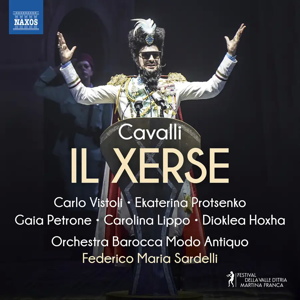
Francesco Cavalli (1602–1676)
Il Xerse, dramma per musica in a prologue and three acts (1655)
Libretto by Nicolò Minato (c. 1627–1698)
Critical edition by Sara Elisa Stangalino and Hendrik Schulze (2019)
Xerse: Carlo Vistoli (countertenor)
Amastre: Ekaterina Protsenko (soprano)
Arsamene: Gaia Petrone (mezzo-soprano)
Romilda: Carolina Lippo (soprano)
Adelanta: Dioklea Hoxha (soprano)
Ariodate: Carlo Allemano (tenor)
Aristone: Nicòlo Donini (bass)
Periarco: Nicòlo Balducci (countertenor)
Elviro: Aco Bišćević (tenor)
Orchestra Barocca Modo Antiquo / Federico Maria Sardelli
rec. live, 29-31 July 2022, Teatro Verdi, Martina Franca, Italy
Libretto and translation available online
Naxos 8.660536-37 [76+76]
In the mid-17th century, Francesco Cavalli succeeded his teacher Claudio Monteverdi as the principal opera composer in Venice, with its several public opera houses. Il Xerse came at a time when mythology in plots was giving way to history. The librettist Nicolò Minato took the story, or at least the context, from Book Seven of the Histories by Herodotus. The libretto was the basis of Giovanni Bononcini’s treatment in 1694, and that in turn served for Handel’s London Serse in 1738.
Before I proceed, let me note that there is a video recording of this production – see a review of the Blu-ray release on the Dynamic label.
The Naxos website says that this is an abridged version. The booklet adds: “The artistic team at Festival della Valle d’Itria have made some cuts to this performance which include removing the Prologue and several scenes.” This seems regrettable in a new critical edition of a major score, but the recording is tied to a specific production. Such adjustments for a particular staging were commonplace. Il Xerse proved highly popular, so Cavalli frequently made cuts and other alterations for performances in Paris, Venice, Genoa, Naples and Bologna.
Xerxes, King of Persia, abandons his betrothed Amastre after falling for Romilda, who loves, and is loved by, the King’s brother Arsamene. He in turn is loved by Romilda’s sister Adelanta. Buffo-style confusions arise, helped by the device of a misdirected love-letter. There are commedia dell’arte roles for servant Elviro and page Clito, but a serious tone is maintained, especially when the main characters sing of their thwarted desires. The musical style is sophisticated. Recitative merges into arioso and aria and back again, often fluently. The musical invention is consistently attractive, sometimes inspired.
The singing is accomplished and responsive to the text – which, we are told, was seen as more important than its musical setting. So, several composers would often set the same libretto.Not that the main roles are not demanding to sing. Venice had vocal virtuosi, and Cavalli clearly had them in mind at times. Doubtless, the very good cast here could be surpassed by a starry line-up in a studio recording (remember those?), but no-one’s singing lets the opera down at any moment.
Carlo Vistoli’s Xerse leads the cast admirably, with fine counter-tenor sound, mastery of musical line, and range of expression. Above all, he has authority, appropriate in the role of a monarch, even if not all his amorous activity is regal. His Act Three lament Lascatimi morir (Let me die), one of the score’s plums, shows superb control. Russian soprano Ekaterina Protsenko sings Amastre equally well, with clear diction and fine bright tone. She is also rhythmically alert in such moments as her aria Regie stelle (Regal stars) in Act One. Gaia Petrone’s Arsamene is almost as fine, in a role that at times lies quite high for her mezzo-soprano. Caterina Lippo as Romilda sings agreeably despite a few minor shrill moments, and is characterful in her vocal acting. Dioklea Hoxha’s Adelanta benefits from a more secure soprano, sweetly lyrical in closing Act One. Tenor Carlo Allemano’s Ariodate is trumpet-toned in his Già la tromba (The trumpet that blared). Aco Bišcevic’s buffo manners are spot on for Elviro, with no comic vocal exaggeration.
More than one reviewer of the staging of this production complained about Stage Director Leo Muscato’s idea that requires characters to clap their hands to deliver an aside to alert the audience that one was coming. One can see how that might soon prove annoying, but it is so discreet a sound that it is barely noticeable on this sound recording.
We know little about the instrumental forces for Venetian opera of the day, but the Orchestra Barocca Modo Antiquo and their excellent conductor Federico Maria Sardelli made choices that sound attractive and plausible. Doron Sherwin’s cornett playing is a frequent delight in the sonic mix. These musicians are specialists in this repertoire, and it shows.
The only previous recording of this opera that I am aware of, but have not heard, had René Jacobs sing the role of Xerse and conduct the performance. It was made in 1985 for Harmonia Mundi (HMX2901175/78), and the four-disc release is quite expensive.
The live performance is well recorded, with fairly little audience intrusion. The booklet has a track listing and timings, notes on Cavalli and the opera, a plot synopsis and artist biographies, all in English only. The Italian libretto and English translation are easily available from the Naxos website. There are numbers in red in the libretto text to indicate the associated tracks on the disc.
Roy Westbrook
Help us financially by purchasing from




















